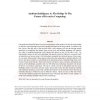Free Online Productivity Tools
i2Speak
i2Symbol
i2OCR
iTex2Img
iWeb2Print
iWeb2Shot
i2Type
iPdf2Split
iPdf2Merge
i2Bopomofo
i2Arabic
i2Style
i2Image
i2PDF
iLatex2Rtf
Sci2ools
119
Voted
FGR
2008
IEEE
2008
IEEE
Ambient intelligence as the bridge to the future of pervasive computing
One prediction about this future of pervasive technology is that people will carry the tools needed to interface with technological resources sprinkled through out the environment. A problem with this vision is the dark side of the network effect: early adopters will end up carrying around interfaces for technology that largely does not yet exist, and building managers will question the value of installing technology with features that almost no one will be able to use. An intermediate solution is that certain buildings with specific needs for efficiency or security (such as hospitals) may become smart, with technology insinuated into particular spaces. Since many, or even most of the people in these spaces will not have the technology to interface directly with the new pervasive resources, we must think of the interaction idiom as initially being closer to the notion of smart environments. These environments will have to sense, interpret, and facilitate the actions of the inhabitan...
Related Content
| Added | 29 May 2010 |
| Updated | 29 May 2010 |
| Type | Conference |
| Year | 2008 |
| Where | FGR |
| Authors | Christopher Richard Wren, Yuri A. Ivanov |
Comments (0)

